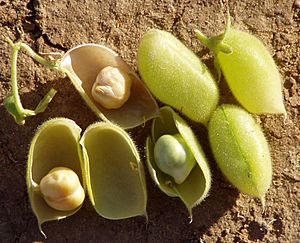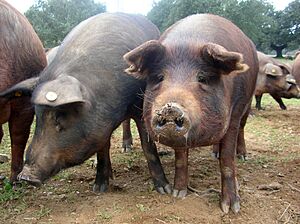Extremaduran cuisine facts for kids
Extremadura, a region in Spain, is famous for its many delicious ways of cooking pork and mutton. Traditional Extremaduran food is usually simple, not fancy, and affordable. It's also known for being generous, as many dishes were cooked in large pots to share with visitors, friends, and neighbors. People usually eat these meals with local bread.
The most popular spices in Extremaduran cooking are paprika (called pimentón), garlic, bay leaves, pennyroyal, and anise. The area of La Vera in the northeast is especially known for its smoked paprika. This paprika is highly valued across Spain and used a lot in Extremaduran recipes. Olive oil is used for frying and is a key ingredient in many dishes. Sometimes, you might find a little bit of coriander leaves in dishes like repápalos or pickled cod. This is a bit unusual for mainland Spain, but it shows some influence from nearby Portugal.
Extremadura also makes its own wine. Most of it comes from the Ribera del Guadiana area. The region is also known for its pitarra tradition, which is homemade wine made in small clay pots.
The Jerte Valley is famous for growing cherries. A special type called picota del Jerte is very popular all over Spain.
Contents
Popular Extremaduran Dishes

Many dishes in Extremadura use pork or mutton. Some well-known ones include callos con manos de cerdo (which is tripe with pig's feet), caldereta de cordero (a tasty mutton stew), and frite de cordero (fried mutton).
The chanfaina in Extremadura is a unique dish. It's a rich stew made from mutton liver, brain, heart, and kidneys. These are cooked with bay leaves, garlic, bread crumbs, and boiled eggs. It's different from other dishes with similar names in Spain.
Traditional Extremaduran food also includes other meats. For example, hen is a main ingredient in the famous cocido extremeño stew. You might also find arroz con liebre (rice with hare) and ancas de ranas fritas (fried frog legs). Local fish like tencas fritas (fried tench) and truchas con jamón (trout with ham) are also popular. In the past, people even ate a type of large lizard in stews or with tomato sauce. However, lizards are now protected, so it's against the law to catch them.
When it comes to fish, some dishes use cod. Tench is a very traditional freshwater fish, used in meals like moje de peces or escarapuche, which mix fish and vegetables.
Many basic popular dishes use chickpeas. Other important ingredients are beans, potatoes, pumpkin, chestnuts, onions, and bell peppers. Some famous Extremaduran dishes are cocido extremeño, potaje de garbanzos y judías blancas (chickpea and bean soup), and potaje de castañas secas (chestnut soup). You can also find different kinds of gazpacho, sometimes with ham or pennyroyal mint.
Soups often use stale bread as a base. There are many types, both hot and cold. Examples include sopa de ajo (garlic soup), sopa de tomate (bread-based soup with tomato, peppers, and egg), and sopa de poleo (pennyroyal mint soup). It's common to eat these soups with figs or even grapes on the side. Sopas canas always have milk, bread, and garlic. Extremaduran ajoblanco is a cold soup that uses egg yolk and sometimes tomatoes, but no almonds.
While rice isn't as common as in some other Spanish regions, rice dishes with rabbit or pork are popular. An example is arroz a la cacereña from Cáceres. After cooking, it's covered with a crust of egg and cheese and then baked.
Vegetables are in many dishes, even if there aren't many purely vegetarian meals. Besides gazpachos, salads are popular. These include picadillo or rinrán, and zorongollo, which is a salad with tomato and roasted peppers. Like in other parts of Spain, pisto (a vegetable stew) is a traditional dish. Local tomato sauce is often called tomatá and goes well with many meals.
Desert truffles, known as criadillas or criadillas de tierra, are eaten with scrambled eggs or fried. While many mushrooms grow in Extremadura, traditionally only a few were eaten, like desert truffles and Macrolepiota procera.
Some old Extremaduran dishes are less common today, like migas (fried bread crumbs) and gachas (a type of porridge). Vegetables like cardoon and borage were once widely used in soups.
Some Extremaduran dishes show influence from nearby Portugal. These include lentejas estofadas (stewed lentils) and sopa de perdices (partridge soup).
Pork Products and Sausages
Extremadura is home to Black Iberian pigs, which often roam freely and eat acorns from local oak trees. This special pig breed is found only in southwestern Spain and Portugal. Their meat, especially their ham, is highly valued across Spain.
Extremaduran cuisine uses a lot of pork. The region is considered one of the best places in Spain for raising pigs, thanks to the many acorns in its dehesa (oak forests).
Some Extremaduran embutidos (pork sausages and cured meats) have a local flavor. These include morcilla «Felisa» (made with blood and onion), morcillas patateras (sausage with mashed potato and pork), and sausages made with pumpkin. Cured pork products include local ham, longaniza, chorizo, salchichón, and caña de lomo. These pork products are often added to local stews like cocido.
Patatera (sometimes called caldillo) is a fatty pork liver pâté seasoned with paprika, garlic, and other spices.
Buche is a type of sausage similar to Leonese botillo. It's made from different pieces of pork left over after butchering, like ribs and bones with a little meat. These are chopped, seasoned, and stuffed into the pig's cecum (a part of the intestine). Once cured, it's usually boiled and then opened. People eat its contents, often with cabbage and other pork products, cooked in the same broth.
Extremaduran Cheeses
Extremadura makes many kinds of cheese. The most famous are Torta del Casar and Torta de la Serena. Both have a special denominación de origen (a protected name that shows where they come from). They are sheep milk cheeses made using a special plant called cardoon to curdle the milk. This gives them a creamy texture and a rich, slightly bitter taste. People traditionally eat these cheeses by cutting off the top and scooping out the soft inside with a spoon to spread on bread. They are a bit like Serra da Estrela cheese from Portugal.
Queso de los Ibores is another cheese with a protected name. It's made in certain areas of the Province of Cáceres. This is a fatty goat milk cheese, made only from the milk of specific goat breeds.
Along the border with Portugal, you can find various goat milk cheeses that are similar to those in Portugal. They are firm and have a strong taste and smell, like Quesaílla cheese, queso de Acehúche, and queso de Gata-Hurdes.
Sweet Treats and Desserts
Extremaduran desserts and sweets are usually made with local wheat flour, honey, pork fat, milk, sugar, and olive oil. Some popular ones include buñuelos (fried dough balls), magdalenas (anise-scented muffins), perrunillas, and galletas (cookies). You might also find roscas fritas (fried doughnuts), coquillos de miel, and sopa de almendras (sweet almond soup).
Some well-known local specialties are tecula mecula from Olivenza, bollo turco from Jerez de los Caballeros, and roscas de alfajor from Casar de Cáceres.
|
See also
 In Spanish: Gastronomía de Extremadura para niños
In Spanish: Gastronomía de Extremadura para niños


